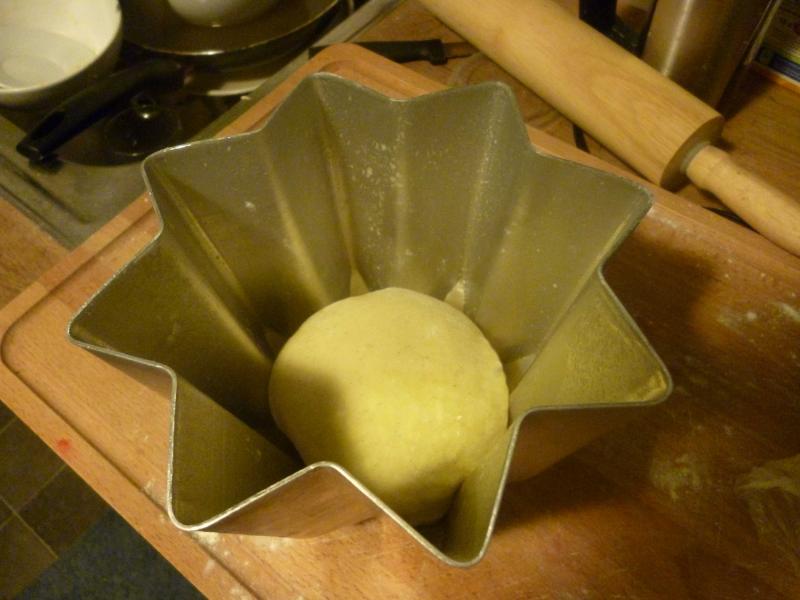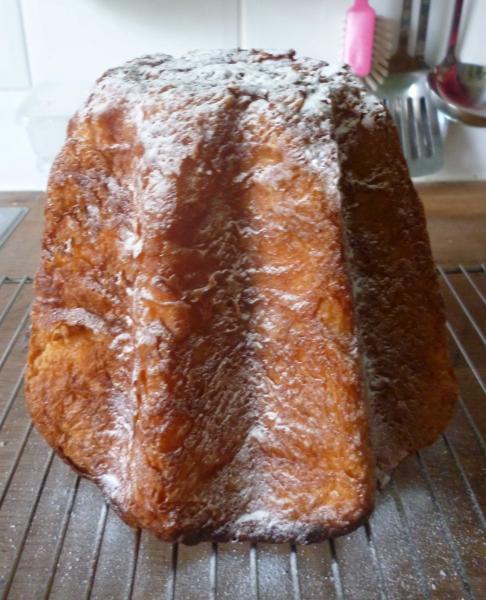
Pandoro a sfoglia
This one isn't very seasonal at the moment, but I love eating it for breakfast. It's so buttery and soft that I really don't think it needs an accompaniment. The recipe is taken from "non solo zucchero vol.II" where it is called pandoro evolution, but it is very similar to the pandoro a sfoglia from Cresci.
Main impasto - in grams
sweet starter (50% humidity) 45
dry active yeast 3
very strong flour 179
sugar 36
unsalted butter (soft but not melted) 27
egg 107
salt 3.5
half a vanilla pod
melted butter flavour 0.3 (I've made this before without the flavouring and it tasted exactly the same - but it's in the recipe so I've included it here).
mix all the ingredients together and work it until it forms a smooth, elastic dough. It should be strong and windowpane, but still very slightly sticky. Wrap it in plastic and put it in the freezer. I left it in there for an about an hour, but the book actually recommends overnight at -10C. While this is firming up, I worked on the butter for lamination:
softened unsalted butter 147
icing sugar 39
mix the two ingredients together thoroughly, then pat into a square, wrap, and put in the fridge to firm up. When both parts are at the right consistency, take 362 of the dough and laminate it as if you were making croissants - 3 simple turns in total, with at least half an hour between each turn. It ought to look something like this when you've finished:

the total weight is 550g.
The difficult bit is then forming this into a ball without breaking the laminations. The book gives absolutely no guidance here whatsoever! I usually fold the ends underneath and then roll it around until it looks more or less spherical. I doubt very much that this is the best method! The dough by this point is really quite resistant to being shaped.

It looks so tiny in the tin - it's hard to believe that it can possibly fill it!
Leave it to prove at about 27C and at least 60% humidity for about 10 - 12 hours. I left mine for 10 hours.

I think it could easily have grown even more than this, so next time I might put less dough in the pandoro tin. As it was, it was just about to start spilling over the edge. If my shaping of the ball had been better then I also think this might have helped.
Leave it in the open air for about 30 minutes in order to form a skin on the dough and then it goes in the oven for 30 minutes at 170C. Leave it in the tin for a few hours after cooking before turning out. Mine stuck a little bit - I should have used more flour and butter to grease the form.
When it's ready to eat (after a few days), dust it in icing sugar and enjoy!

I was very happy with the crumb on this one - really light and shreddy, with a wonderfully complex buttery taste. It just fell to pieces as I was cutting and eating it.

David


Comments
That's fantastic.
Resting the dough in the fridge after the last fold and before shaping may help.
thanks Peter!
I've tried resting the dough after the final fold but the truth is it really just doesn't want to form a ball! I found that the re-hardened butter resists attempts to shape it and can even rip the dough. Maybe I should let it rest for longer, roll it out a bit to soften and then shape? I'll try that next.
David
How about letting the dough warm up a little at the end? As long as it's under the butter melting point the lamination should be ok. Maybe 55-65F?
Hmm, on second thought & looking again at the photo, your result is very nice, do you really have a problem? Your crumb looks about the right density. Also, when the dough rises above the lip of the mold, it will no longer have the support and should tend to spread more. There is probably an optimum height determined by the hydration and the relation of the dough to the mold.
The truth is I am happy with the result. The pandoro has a good flavour, and the texture seems to me to be very similar to those artisan ones I've eaten in Italy. However there's a photo in the book Cresci which is tormenting me - it shows this recipe with a crumb so ripped open it resembles more a croissant than a pandoro. Now I'm not one of those who thinks that the bigger the hole the better the bread, but until I know how that texture was achieved I shan't sleep easy. Perhaps I do need to let the dough spread out more at the top... the photo in Cresci would seem to imply that this has happened. There's very little oven-spring in this bread (unlike a panettone) so perhaps it's simply a case of proving a little more.
The age and amount of the levain has a lot to do with the state of the crumb (not to be confused with the state of the union--which, to some, is crummy...). I have not made enough pandoro's to play with this, but to get that open, webbed, shreddable crumb in croissants I get the best results with 20% poolish. Sourdough is ok, too, but can make the dough too tenacious if used in excess and overly mature. Pandoro depends on relatively young starters to minimize the acid content and, presumably, minimize the effect on flavor. MWilson has written extensively on this and Cresci formulas on this forum; his posts are worth a look if you haven't seen them.
Thinking about this, the paradox of a laminated pandoro is that you want as strong a dough as you can get without so much so that the rolling out impossible. I've made croissants with sourdough where I've laminated a sourdough containing dough both before and after bulk fermentation. The latter is forgettable. You might consider mixing your flour and eggs first and developing the gluten as much as possible then adding your sugar and finally butter. My other thought is to let your biga age a little longer. The additional amount of acid could be significant to dough development without negatively affecting the taste.
Thanks for the suggestions! My bad in the description - I worked the eggs and flour before adding the sugar and finally the butter. The end result is a very elastic dough with strong gluten development. The sourdough ought not to be a problem, as I follow the cresci method and regularly check the pH. I love Michael Wilson's blog, I'm glad I'm not the only person out there obsessed with Italian sweet breads!
I've just made a quick comparison between the recipes given in "cresci" and "non solo zucchero vol.II" and - very interesting this - the photo in "non solo zucchero vol.II" looks exactly like the pandoro I've made, same texture and same crumb (as far as can be judged from a photo!). The only difference that I can see between the two recipes is the strength of the flour recommended. The cresci flour is quite a bit weaker. Perhaps this is a case of too much gluten development to make the laminated "cells" which I can see in Cresci. I've no (easy) way of checking the strength of my flour to compare - the Italian system of using the "w" number is much more accurate than the UK strong and very strong labels.
I've also just remembered something I read in txfarmer's amazing blog about her experiments with croissants. She adjusted the butter content to take into account the fact that she wasn't using a dough sheeter. Perhaps this too might have an effect. I think I need to re-read that particular entry and then to make another one to see what happens :))
makes me hungry! Very nice baking.
Thanks very much! If you lived in the UK I'd send you one, but alas...!
Almost missed this: you proofed at 27C (80F). I know that is typical for pandoro--and croissants--but, coupled with such a long duration and any extra internal heat of fermentation, could lead to some loss of lamination as the butter disperses into the dough.
Now that is something that hadn't occurred to me! A very interesting point, and certainly a possibility. I suppose the only way to test it would be to make another and prove it at a lower temp, say 23 or 24C. I'd worry though that this would give the starter too much time to increase the acidity of the dough. One of the characteristics of pandoro is that it isn't very acidic, at least in comparison to panettone. It already takes 10 hours or so at 27C, I dread to think how long it would take at 23C.
That's some serious rise you got there! I did attempt the Cresci version once thinking I could omit the yeast - big mistake! I also had the same problem with the dough becoming overly stiff.
Well done, it's a beauty and looks very tasty indeed...
Where did you get the melted butter flavour from?
Michael
I found the melted butter flavour in a little cake decorating shop near Purley, Surrey. They had one bottle stuck behind a load of other bottles of glycerine and such. The smell was fairly repulsive but I thought I'd give it a go. I can't really say that it added anything much in flavour... perhaps the flavouring that Massari uses in much more concentrated. I also found some on a french site, which is excellent, but I wasn't prepared to pay £20 postage for a £2 bottle. The link is http://www.cuisineaddict.com/ they really do seem to have everything!
I was (it's all eaten now) very happy with the pandoro, but I'm sure you know the photo in the book. And the photo for the bussola a sfoglia! Amazing crumb structure. And they both have this enormous "roll" of dough around the base, somthing I've not yet managed to achieve. The more I think about it, the more I'm convinced it's a lamination issue. Non solo zucchero recommends proving at 27C, but cresci says 20 - 22C. But he says they should both take about 10 hours!! How is that possible?
David